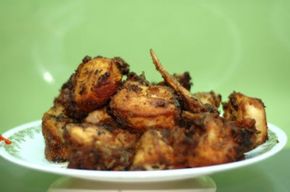“
 “Perfect fried chicken: Crispy outside, moist and tender inside. See more fried food with these fried food pictures.Elyanna Samsudin
“Perfect fried chicken: Crispy outside, moist and tender inside. See more fried food with these fried food pictures.Elyanna Samsudin
Q. What do I need to know if I want to make some deep-fat fried food at home?
A. Crisp and golden outside, moist inside — few cooking techniques can match the results produced by deep-fat frying.
While frying has been much maligned in today’s health-conscious climate, the occasional fried dish can prove a delicious addition to any cook’s repertoire. You simply need to understand temperature, the kind of oil you will be working with and how to do it safely.
Too Hot, Too Cold…Just Right!
When frying foods in hot fat, proper fat temperature is critical. The ideal temperature produces a crisp exterior and a moist but thoroughly cooked interior. Too high of a temperature will burn the food. Too low of a temperature will result in food absorbing excessive amounts of fat. Fat should not be allowed to smoke–smoking is a sign that the fat is beginning to break down, and this will affect the flavor.
A deep-fat thermometer is essential for determining the temperature of the fat. Use a deep-fat thermometer to check the temperature of the fat even if you’re using an electric deep fryer. If a thermometer isn’t available, drop a cube of white bread in the hot oil. The bread will brown evenly in 1 minute at 350°F to 365°F, in 40 seconds at 365°F to 380°F, and in 20 seconds at 380°F to 390°F.
Oil’s Well That Ends Well
The best fats for frying have little or no flavor and a high smoke point (the temperature at which fat smokes and begins to break down). A fat’s smoke point is reduced with each use, so it’s important to discard the fat after three uses. Corn, peanut, and soybean (sold as vegetable) oils are good for frying.
Safety Patrol
Do not leave hot fat unattended — oil that gets too hot can ignite. If this happens, immediately cover the pan to cut off oxygen to the flames. Baking soda or salt thrown on the flames will also extinguish them. Do not attempt to douse a grease fire with water. This will cause the oil to splash and spread the flames.
To avoid spattering, foods should be free of surface moisture before frying. Fill the cooking pan no more than half full of fat to allow space for the food.
Deep-fat frying has long been a favorite of cooks and has only recently fallen out of favor as the various health consequences of a diet heavy in fried foods came to light. Still, for most people, the occasional fried treat should not pose a problem.
For more information and recipes, check the links below:
- Fried Onion Recipe
- Southern Buttermilk Fried Chicken Recipe
- Southern Fried Catfish with Hush Puppies Recipe
- Fried Wonton Recipe


